Did you know that tomatoes are the most widely grown fruit in the world? In fact, over 170 million tons of tomatoes are harvested each year, with China being the largest producer. But you don’t need a massive farm to enjoy the taste and freshness of homegrown tomatoes. With the right knowledge and a little bit of space, you can grow your own lush tomato tree right at home!
Key Takeaways:
- Growing tomatoes in containers is a great option for those with limited space.
- Choose the right container size and type for optimal growth.
- Ensure your tomato tree gets enough sunlight, water, and nutrients.
- Regular pruning and maintenance are key to a healthy and productive plant.
- Harvest your tomatoes at the right stage of ripeness for the best flavor.
The Benefits of Growing Tomatoes in Containers
Growing tomatoes in containers offers numerous advantages that make it an attractive option for both experienced gardeners and beginners. Container plants provide greater protection against critters and pests, reducing the risk of damage to your tomato tree. Additionally, container gardening allows for better resistance against common diseases found in traditional garden beds, ensuring a healthier plant and improved yield.
“Growing tomatoes in containers offers greater protection against pests and diseases, resulting in healthier plants and better harvests.”
When selecting tomato tree varieties for container gardening, it is advisable to choose determinate types. Determinate tomato trees are naturally compact and grow to a predetermined size. This makes them well-suited for containers, as their compact growth habit requires less space. Determinate varieties are easier to manage and support within the confines of a container, allowing for more convenient care and maintenance.
If you have a larger container and the necessary support, it is also possible to grow indeterminate tomato trees in containers. Indeterminate varieties typically grow taller and produce an ongoing harvest throughout the season. With adequate support structures and sufficient space, indeterminate tomatoes can thrive in containers and provide you with a bountiful supply of juicy tomatoes.
Whether you prefer determinate or indeterminate varieties, the benefits of growing tomatoes in containers are clear. Not only do container plants offer enhanced protection against pests and diseases, they also allow for successful cultivation of compact tomato tree varieties in limited spaces. With the right care and attention, you can enjoy a productive and rewarding tomato gardening experience right on your balcony, patio, or even indoors.
| Benefits of Growing Tomatoes in Containers |
|---|
| Enhanced protection against pests and diseases |
| Ability to grow compact determinate varieties |
| Potential for successful growth of indeterminate varieties with proper support |
| Convenient gardening option for limited spaces, including balconies and patios |
| Possibility for indoor tomato tree cultivation |
“Growing tomatoes in containers offers enhanced protection against pests and diseases, allows for compact and limited-space gardening options, and accommodates indoor cultivation.”
Choosing the Right Container
Choosing the right container is crucial for the success of your tomato tree. Whether you’re growing determinate or indeterminate varieties, selecting an appropriate container size and type will provide the necessary space for root development and ensure optimal growth and yield. Here are some important considerations:
Determinate varieties
Determinate tomato varieties have a predetermined size and tend to be more compact. To accommodate their growth and provide adequate support, it is recommended to plant them in at least 10-gallon containers. This will allow the roots to spread out and provide stability to the plant as it matures.
Indeterminate varieties
Indeterminate tomato varieties are known for their vigorous growth and can reach considerable heights. To support their growth and allow the roots to thrive, larger containers are necessary. It is recommended to use at least 20-gallon containers for better root development and stability.
Fabric pots are highly recommended for growing tomato trees in containers. These pots allow for better aeration and drainage, preventing waterlogging and promoting healthy root growth. Additionally, fabric pots help regulate soil temperature, reducing the risk of root stress during extreme weather conditions.
When choosing a container, it is important to use high-quality potting soil that is specifically formulated for container gardening. This type of soil provides excellent drainage and aeration, creating an optimum growing environment for your tomato tree. Adding organic fertilizers and amendments to the soil will further enhance the nutrient content and contribute to a healthy plant.
Here is a summary of the recommended container sizes for growing tomato trees:
| Variety | Container Size |
|---|---|
| Determinate | At least 10 gallons |
| Indeterminate | At least 20 gallons |
Note: These container sizes are guidelines and can be adjusted based on the specific requirements of the tomato tree variety you are growing.
With the right container size and proper soil preparation, you can create an ideal environment for your tomato tree to flourish. In the next section, we will explore the proper planting techniques to ensure a successful start for your tomato tree.
Proper Planting Techniques
When it comes to growing a tomato tree, proper planting techniques are essential for ensuring healthy growth and a bountiful harvest. Here’s a step-by-step guide to help you get started:
1. Repotting and Hardening Off
Before planting your tomato plant, make sure it has been repotted at least once. This helps promote strong root development and overall plant health. Additionally, it’s important to properly harden off your tomato plant by gradually exposing it to outdoor conditions. This will help the plant acclimate to the sunlight, temperature, and wind.
2. Choose a Sunny Location
Tomatoes thrive in full sun, so choose a location that receives 8 to 10 hours of direct sunlight per day. This will provide the plant with the energy it needs for optimal growth and fruit production.
3. Prepare the Planting Hole
Dig a hole in the potting soil that is slightly larger than the root ball of your tomato plant. Adding amendments to the soil can provide essential nutrients for healthy growth. Consider incorporating tomato/vegetable fertilizer, fish meal, bone meal, aspirin tablets, and crushed eggshells for added nutrition.
4. Planting Depth
When planting your tomato plant, bury the stem up to the first set of leaves. This encourages the plant to develop additional roots along the buried stem, leading to a stronger and more robust plant.
5. Thoroughly Water
After planting your tomato plant, thoroughly water the soil to ensure it is evenly moist. This helps the plant establish its roots and reduces the risk of transplant shock. Regular watering is crucial throughout the growing season to keep the soil consistently moist but not waterlogged.
Sun and Soil Requirements
When it comes to growing a healthy tomato tree, providing the right amount of sunlight and choosing the correct soil are essential. In this section, I will discuss the sun and soil requirements that will help your tomato tree thrive.
Sunlight: A Key Ingredient for Success
Tomato trees are sun-loving plants that require at least 6 to 8 hours of direct sunlight per day. This ensures optimal growth, strong stems, and vibrant fruit production. So, it’s essential to choose the sunniest spot in your garden or balcony for your tomato tree.
Soil: The Foundation for Healthy Growth
The soil you choose for your tomato tree should be rich, well-draining, and slightly acidic, with a pH level of 6.5 to 6.8. Conducting a soil test will help you determine the pH level and make any necessary amendments to achieve the optimal balance for your tomato tree’s growth.
| Soil Type | Advantages | Disadvantages |
|---|---|---|
| High-quality potting soil | Provides excellent drainage and aeration | May be more expensive |
| Homemade potting mix | Allows customization and control over nutrient levels | Requires careful preparation and quality ingredients |
It’s important to note that using garden soil is not recommended for container-grown tomato trees as it may contain pests and diseases that could harm your plants.
“Choose the sunniest spot for your tomato tree and provide it with a rich, well-draining soil to ensure healthy growth and bountiful harvests.”
Watering and Fertilizing
Proper watering and fertilizing are crucial for maintaining the health and productivity of your tomato tree. By following these essential practices, you can ensure that your tomato tree thrives and produces a bountiful harvest.
When it comes to watering, it’s important to strike a balance. Water your tomato tree deeply and gradually to ensure the soil is evenly moist but avoid overwatering, as this can lead to root rot and other diseases. Additionally, be mindful not to let the soil dry out completely, as this can cause stress to your plant.
To help retain moisture and prevent weed growth around your tomato tree, consider mulching the soil. Organic materials such as grass clippings or composted leaves work well as mulch. Apply a layer of mulch around the base of the plant, taking care not to pile it against the stem.
Tomatoes are heavy feeders and require regular fertilization to ensure optimal growth and fruit production. Use a balanced fertilizer with a higher potassium and phosphorus ratio to promote healthy root development and abundant fruiting.
It’s important to note that different tomato varieties have unique nutrient requirements. Before applying fertilizer, consult the specific instructions provided by the seed or plant supplier, as they will outline the ideal feeding schedule and fertilizer ratio for your tomato tree.
Pro Tip:
When fertilizing your tomato tree, consider using organic options as they can provide a more natural and sustainable approach to nourishing your plants. Compost, worm castings, and seaweed extracts are great alternatives to synthetic fertilizers. These organic fertilizers not only provide essential nutrients but also improve the soil structure and microbial activity, creating a healthier environment for your tomato tree.
Watering and Fertilizing Summary:
| Watering | Fertilizing |
|---|---|
| – Water deeply and gradually | – Use a balanced fertilizer with higher potassium and phosphorus ratio |
| – Ensure the soil is evenly moist | – Follow the recommended feeding schedule |
| – Avoid overwatering and allowing the soil to dry out completely | – Consider using organic fertilizers for a more natural and sustainable approach |
| – Mulch the soil to retain moisture |
Pruning and Maintenance
Regular pruning is key to maintaining a healthy and productive tomato tree. By removing suckers that grow in the leaf axils, you can improve air circulation and direct the plant’s energy towards fruit production. Additionally, trimming yellowing leaves ensures optimal lighting and air circulation, promoting overall plant health.
Watering is an essential aspect of tomato tree care. Initially, water your tomato tree every two to three days. Once it starts producing fruit, increase the frequency to daily watering. This ensures that the plant receives adequate moisture, which is crucial for healthy growth and bountiful harvests.
If you are growing tomato trees indoors, pollination may be necessary. You can manually pollinate the flowers by gently transferring pollen from the stamen to the stigma using a soft brush or your finger. This will aid in fruit development and promote a successful harvest.
Remember to monitor your tomato tree regularly for any signs of pests or diseases. Taking prompt action is crucial to protect the plant and maintain its health. If necessary, use organic insecticides or fungicides to address any issues and safeguard your tomato tree.
“Regular pruning, proper watering, and vigilant maintenance are essential for the success of your tomato tree. By providing the necessary care, you can ensure a healthy and productive plant that rewards you with delicious homegrown tomatoes.”
| Pests | Signs | Treatment |
|---|---|---|
| Aphids | Stunted growth, curled leaves | Use insecticidal soap or neem oil |
| Hornworms | Defoliation, eaten fruit | Handpick and destroy, use Bacillus thuringiensis |
| Whiteflies | Sticky residue, yellow leaves | Use yellow sticky traps, introduce natural predators |
| Early Blight | Spots on leaves, stem rot | Remove infected leaves, use copper-based fungicides |
| Septoria Leaf Spot | Small black spots on leaves | Remove infected leaves, use copper-based fungicides |
Note: Proper identification of pests and diseases is essential for effective treatment. Consult with a local gardening expert or extension service for accurate diagnosis and recommendations.
Protecting Your Tomato Tree
Protecting your tomato tree from pests and diseases is essential for maintaining its health and ensuring a successful harvest. By implementing a few strategies, you can create a thriving and pest-free environment for your tomato plant.
Companion Planting
One effective method to repel pests and provide beneficial pollinators is through companion planting. Consider planting basil, garlic, onions, and marigolds near your tomato tree. These plants act as natural repellents for common pests like aphids, whiteflies, and hornworms. The strong scents of these companion plants help deter pests from attacking your tomato tree.
Proper Mulching and Watering
Mulching the soil around your tomato tree can help maintain proper moisture levels and prevent weed growth. Use organic materials such as straw or compost to create a layer of mulch around the base of the plant. This will help retain moisture in the soil and regulate its temperature.
A soaker hose is an excellent watering tool for tomato trees. It provides a slow and steady water flow, ensuring that the roots receive consistent moisture. Avoid overhead watering, as it can increase the risk of fungal diseases.
Monitoring for Pests and Diseases
Regularly inspect your tomato tree for signs of pests or diseases. Look for chewed leaves, discoloration, or wilting. Some common pests that may affect tomato trees include aphids, tomato hornworms, and whiteflies. If you notice any signs of infestation, take immediate action to control the pests.
Using organic insecticides or fungicides can offer effective protection against pests and diseases without harming the environment. Be sure to follow the instructions provided by the manufacturer when applying these products.
| Pest | Prevention | Treatment |
|---|---|---|
| Aphids | Companion planting with marigolds and regular monitoring. | Use insecticidal soap or neem oil spray. |
| Tomato Hornworms | Inspect plants regularly and manually remove worms | Apply Bacillus thuringiensis (BT) or spinosad-based insecticides. |
| Whiteflies | Companion planting with basil or garlic. | Use yellow sticky traps or insecticidal soap. |
Regularly monitoring your tomato tree and taking quick action against pests and diseases will help prevent damage and ensure the health of your plant.
Protect your tomato tree from pests and diseases with companion planting, proper mulching, and regular monitoring. By creating a favorable environment, you can ensure the health and productivity of your tomato plant, resulting in a bountiful harvest.
Harvesting and Storing Tomatoes
Harvest your tomatoes when they are at least halfway ripe and have a firm texture. Large heirloom varieties often ripen from the inside out, so it’s important to pick them before they become overripe. Handle the tomatoes gently to prevent bruising or damage. Store unripened tomatoes in a loosely closed paper bag to speed up the ripening process. If you have an excess of ripe tomatoes, consider freezing them for later use in soups, salads, or sauces.
| Tomato Variety | Characteristics | Best Uses |
|---|---|---|
| Roma | Oval-shaped, meaty, and less juicy | Canning, sauces, and tomato paste |
| Cherry | Small, round, and sweet | Salads, snacking, and garnishing |
| Beefsteak | Large, juicy, and meaty | Slicing, burgers, and sandwiches |
| Early Girl | Medium-sized, early maturing | General use, salads, and sandwiches |
Tips for Successful Tomato Tree Growth
To promote successful tomato tree growth, it’s important to provide proper care and attention. Here are some tips to help you cultivate a thriving tomato plant:
-
Ensure Adequate Sunlight: Tomato trees require at least 6 to 8 hours of direct sunlight per day. Choose a sunny spot in your garden or balcony where the plant can bask in the sun’s rays. Adequate sunlight will encourage healthy growth and fruit production.
-
Proper Watering: Water your tomato tree deeply and gradually, ensuring the soil is evenly moist. Avoid overwatering, as it can lead to root rot, and also prevent the soil from drying out completely. Mulching the soil can help retain moisture and suppress weed growth.
-
Regular Pruning: Prune your tomato tree regularly to maintain airflow and optimize fruit production. Remove suckers that grow in the leaf axils to prevent overcrowding and focus the plant’s energy on developing healthy fruits.
-
Protect from Pests and Diseases: Companion planting with basil, garlic, onions, and marigolds can help deter pests and promote a healthy growing environment for your tomato tree. Monitor the plant regularly for signs of pests or diseases and take appropriate action to prevent damage.
-
Harvesting: Harvest your tomatoes at the right stage of ripeness. They should be at least halfway ripe and have a firm texture. Handle the tomatoes gently to avoid bruising or damage.
Expert Tip: Always support your tomato tree with stakes or a trellis to prevent it from sprawling and ensure proper growth.
By following these tips, you can enjoy the rewards of growing your own lush tomato tree at home. Remember to provide adequate sunlight, water, and care, and you’ll be rewarded with a bountiful harvest of delicious tomatoes.
“Proper care and attention are essential for successful tomato tree growth. With the right techniques, you can cultivate a thriving plant and enjoy the taste of homegrown tomatoes.”
– Gardening Expert
Tools and Resources for Growing Tomato Trees
When it comes to growing tomato trees, having the right tools and resources is essential to ensure success. Whether you need gardening supplies or innovative solutions for indoor growing, there are options available to meet your needs.
If you’re looking for a one-stop shop for all your tomato tree needs, consider shopping online at The Home Depot. They offer a wide range of gardening supplies, including tools, seedlings, and garden soil. With their convenient delivery service, you can have everything you need conveniently brought to your location.
If you prefer to grow tomato trees indoors, Gardyn is an excellent solution to explore. With its automated monitoring system, Gardyn ensures that your tomato trees receive optimal lighting, air circulation, and nutrient levels throughout their growth cycle. This innovative technology takes the guesswork out of indoor gardening, making it easier than ever to grow healthy and thriving tomato trees.
By utilizing these tools and resources, you can embark on your tomato tree growing journey with confidence, knowing that you have everything you need for successful cultivation and a bountiful harvest.
Conclusion
Growing a lush tomato tree in a container is an incredibly rewarding experience that allows you to savor the flavors of homegrown tomatoes, even with limited space. By employing proper planting techniques, providing adequate sunlight and water, and practicing regular maintenance, you can achieve robust growth and abundant harvests from your tomato plant. Whether you opt for determinate or indeterminate varieties, the joy of nurturing a tomato tree in your own garden is within reach.
With the right care and attention, your tomato tree will thrive and provide you with a bountiful harvest of delicious tomatoes. Remember to choose the appropriate container size, use high-quality potting soil, and fertilize regularly to ensure optimal plant health. Pruning, monitoring for pests and diseases, and protecting your tomato tree will help it reach its full potential.
Start your own tomato tree journey today and enjoy the incomparable taste of homegrown tomatoes. Whether you have a spacious backyard or a small balcony, growing tomatoes in containers is a fantastic way to bring fresh, flavorful produce to your table. Get your hands dirty, nurture your plant, and relish the satisfaction of growing your own tomato tree.

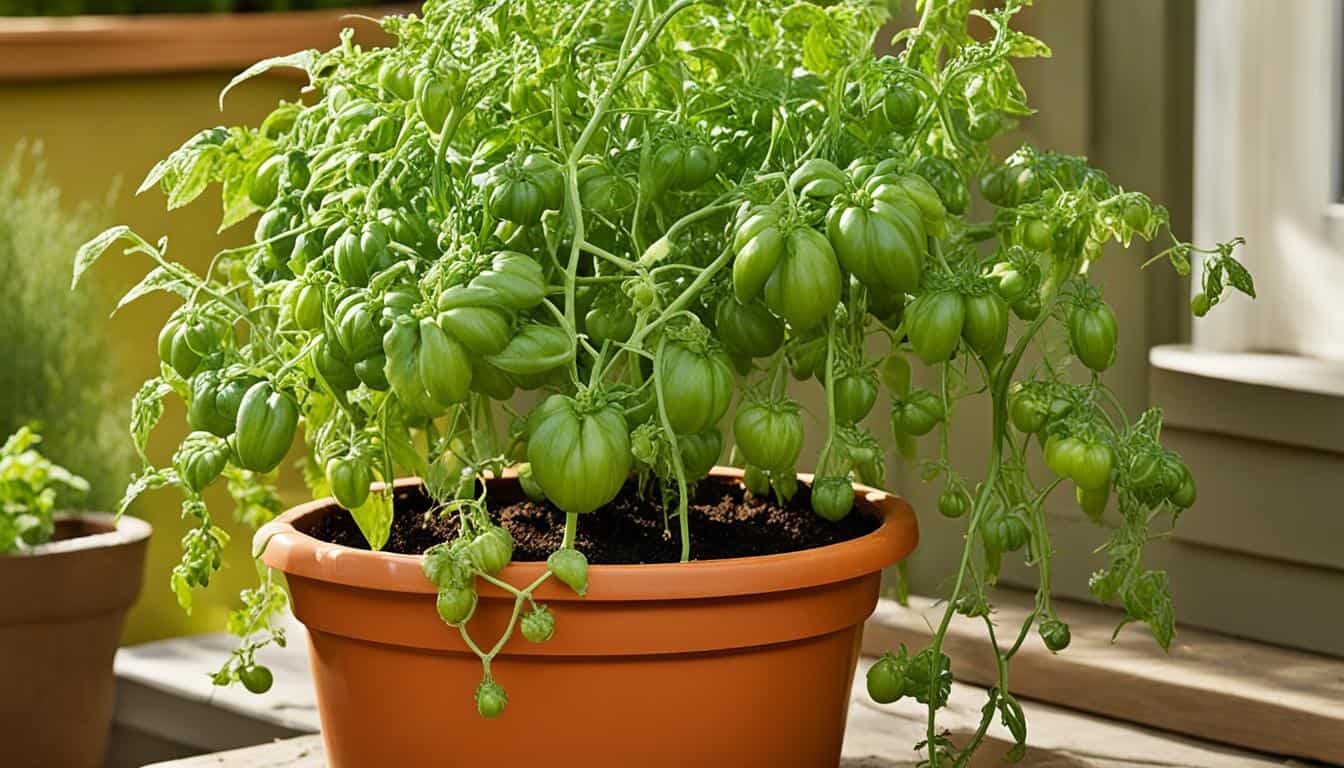
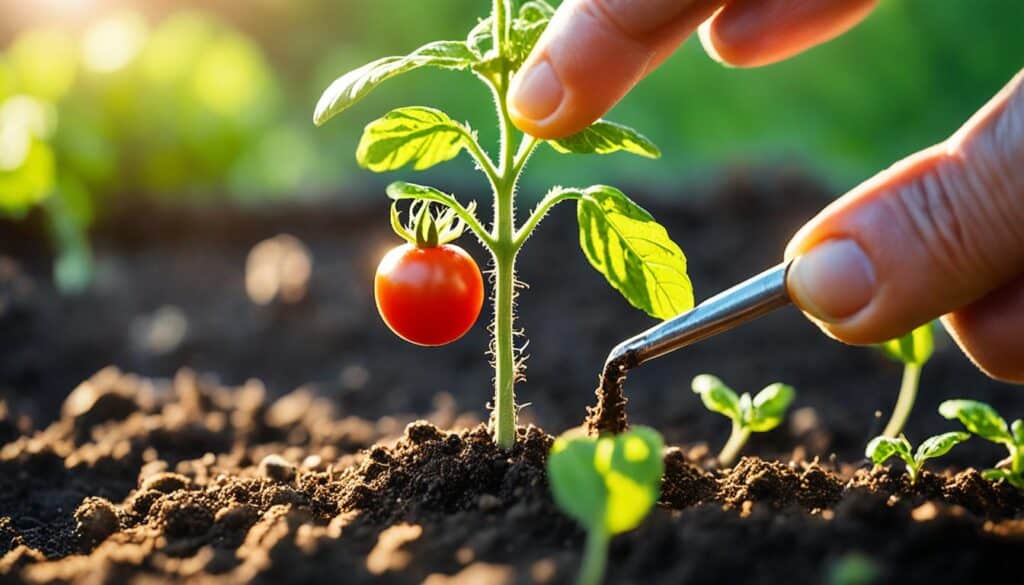
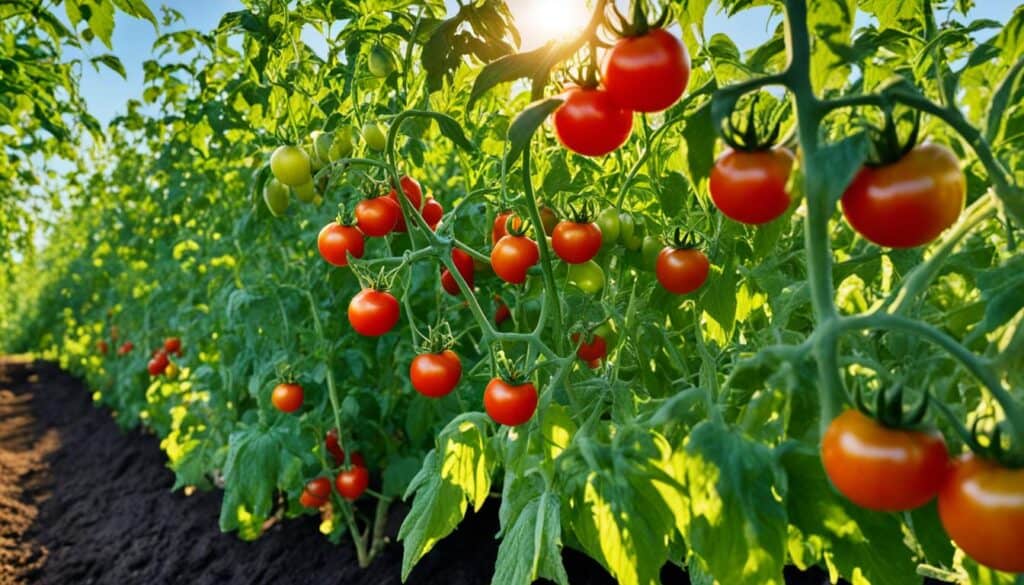

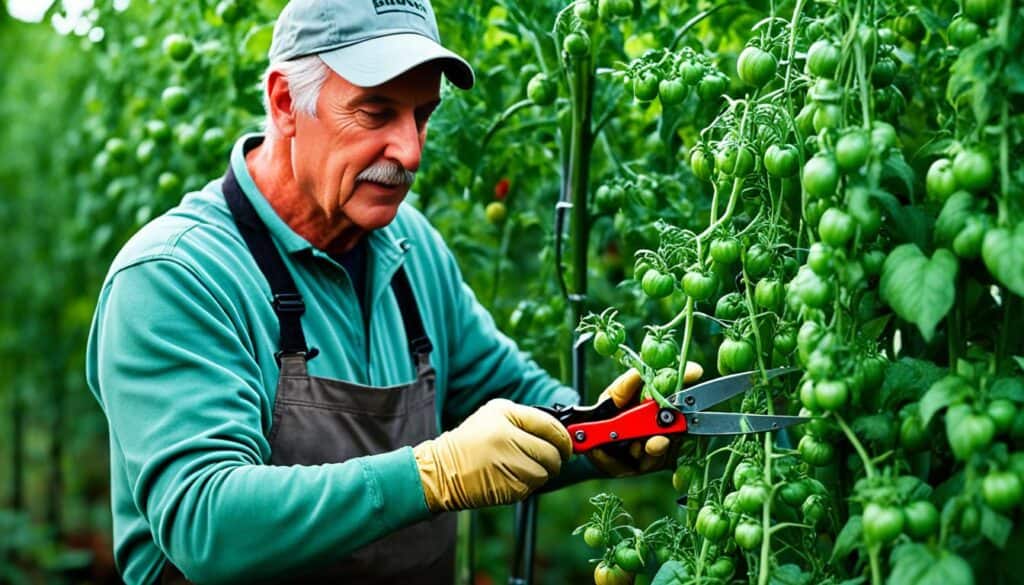
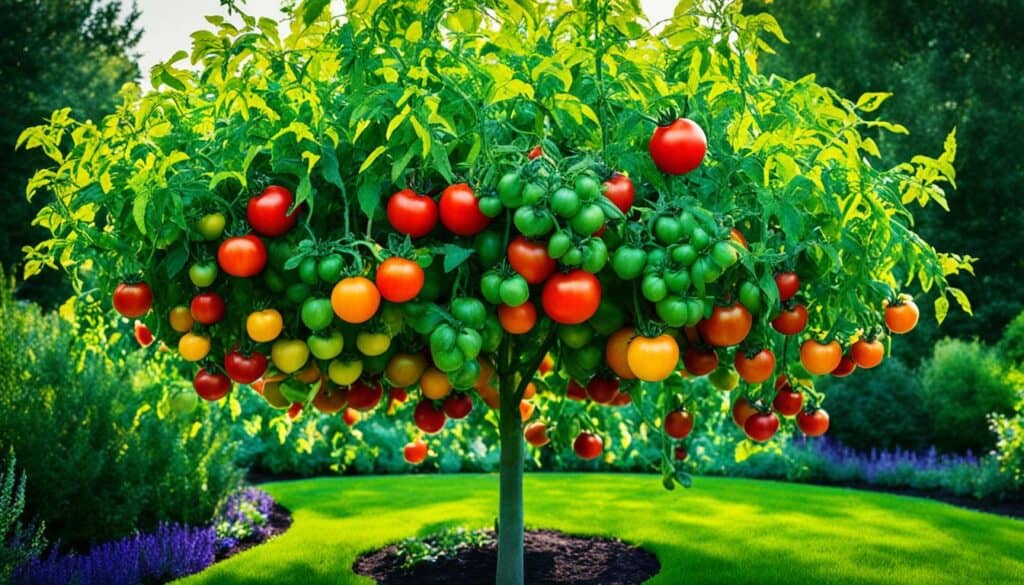

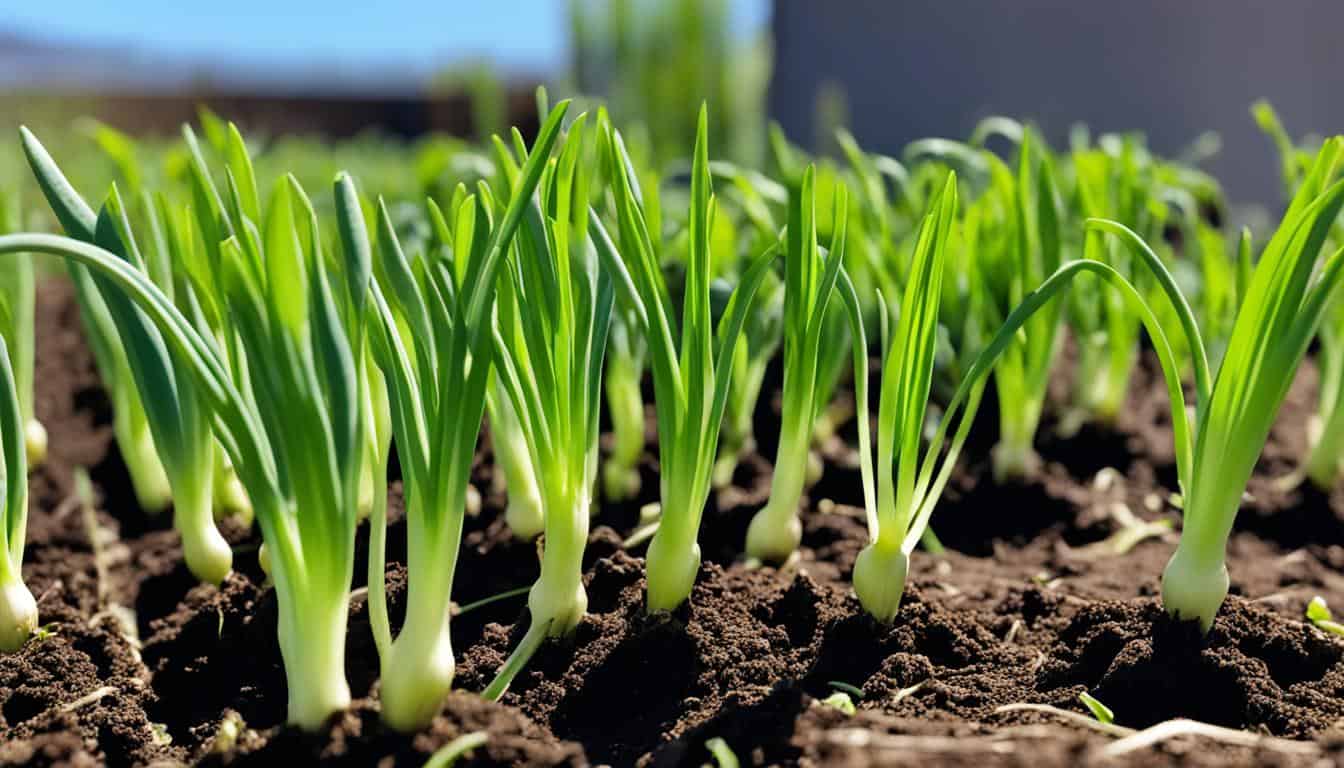

Leave a Reply